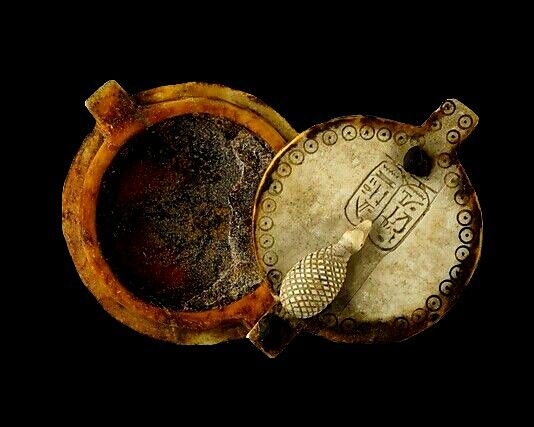The unguent box of Queen Nefertari, created from luxurious materials such as ebony, hippopotamus ivory, and rosewood, stands as one of the most exquisite examples of ancient Egyptian craftsmanship. Dating back to around 1270 BC during Egypt’s 19th Dynasty, this artifact not only signifies royal wealth but also showcases the exceptional artistry and symbolism of the period.
Symbolism and Materials
The unguent box is a striking piece, both in terms of its functionality and aesthetic value. Crafted from ebony, hippopotamus ivory, and rosewood, these materials were not only rare and valuable but also symbolized the opulence of Egypt’s royal court. The durability of these materials ensured that the box would endure through the ages, remaining a testimony to the luxury of the time. The box likely served to hold perfumes or ointments, substances that were integral to the daily life of the Egyptian elite and played significant roles in both daily rituals and religious ceremonies.

The craftsmanship is evident in every detail of the design. The materials were carefully selected not only for their beauty but also for their symbolic importance. Ebony, often associated with luxury and status, formed the structure of the box, while hippopotamus ivory and rosewood added contrast and texture, highlighting the skillful artistry of Egyptian craftsmen. These materials were also used in other royal artifacts, emphasizing the craftsmanship and artistic excellence of the ancient Egyptian artisans.
The Symbolic Hedgehog
An especially intriguing feature of the box is the tiny hedgehog figure, placed in front of a knob. This figure holds deep symbolic significance in ancient Egyptian culture, representing the cycle of life, death, and rebirth. In Egyptian mythology, the hedgehog was believed to have protective qualities and was linked to the idea of renewal and regeneration—concepts central to the Egyptian view of the afterlife. The presence of such motifs on a royal object signifies the importance of spiritual protection and the continuity of life beyond death, beliefs that were integral to Egyptian religious practices.

Royal Cartouches: A Declaration of Divine Rule
On the lid of the unguent box are the cartouches of Ramesses II and Queen Nefertari, which further emphasize the box’s connection to Egypt’s ruling elite. These cartouches, which enclose the royal names, were symbols of divine kingship and power. The inclusion of both Ramesses II and Nefertari highlights their shared rule and the queen’s elevated status alongside her husband. The cartouches also serve to immortalize the names of the royal couple, reinforcing their divine legitimacy and their sacred role in Egyptian society.
This personal connection between the object and the royal family underscores the spiritual and political power of the ruling couple during the 19th Dynasty. The cartouches signify not only the queen’s status as consort but also her divine role, as Egyptian queens were often considered embodiments of goddesses on Earth, thus linking her directly to the divine order.
Artistic Mastery and Cultural Significance
Beyond its function as a luxury item, the unguent box is a masterpiece of ancient Egyptian art. It embodies the Egyptians’ remarkable ability to blend beauty with meaning, merging artistry with spiritual symbolism. The meticulous craftsmanship, the use of rare materials, and the incorporation of potent symbolic motifs all reflect the cultural richness and spiritual depth of ancient Egypt.
The box also offers a glimpse into the daily life of Egypt’s elite during the 19th Dynasty, a period of immense power and wealth under the reign of Ramesses II, one of Egypt’s greatest pharaohs. While it served a practical function, the box was also a symbol of the queen’s role in both the physical and spiritual realms of Egypt, underscoring her importance not only as a ruler’s consort but also as a figure of divine significance.
Conclusion: A Testament to Egyptian Royalty
The unguent box of Queen Nefertari is far more than a functional object; it is a reflection of the luxury, spirituality, and craftsmanship of ancient Egypt. A symbol of divine rule and renewal, it highlights the importance of symbolic objects in the lives of the Egyptian elite. As a relic from the 19th Dynasty, it serves as a lasting testament to the sophistication and grandeur of ancient Egyptian royal culture, offering invaluable insights into the symbolism and artistry of one of the world’s most remarkable civilizations.

